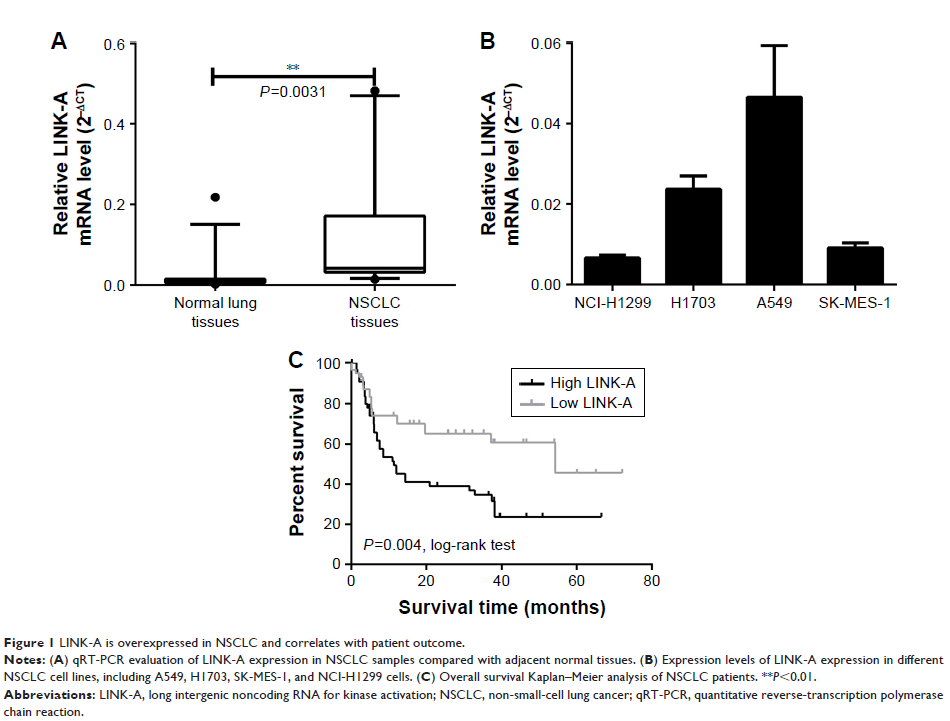9 0 5 7 8
论文已发表
注册即可获取德孚的最新动态
IF 收录期刊
- 2.6 Breast Cancer (Dove Med Press)
- 3.9 Clin Epidemiol
- 3.3 Cancer Manag Res
- 3.9 Infect Drug Resist
- 3.6 Clin Interv Aging
- 4.8 Drug Des Dev Ther
- 2.8 Int J Chronic Obstr
- 8.0 Int J Nanomed
- 2.3 Int J Women's Health
- 3.2 Neuropsych Dis Treat
- 4.0 OncoTargets Ther
- 2.2 Patient Prefer Adher
- 2.8 Ther Clin Risk Manag
- 2.7 J Pain Res
- 3.3 Diabet Metab Synd Ob
- 4.3 Psychol Res Behav Ma
- 3.4 Nat Sci Sleep
- 1.9 Pharmgenomics Pers Med
- 3.5 Risk Manag Healthc Policy
- 4.5 J Inflamm Res
- 2.3 Int J Gen Med
- 4.1 J Hepatocell Carcinoma
- 3.2 J Asthma Allergy
- 2.3 Clin Cosmet Investig Dermatol
- 3.3 J Multidiscip Healthc

LINK-A 通过调节非小细胞肺癌中的有氧糖酵解来促进细胞增殖
Authors Zhao W, Li W, Dai W, Huang N, Qiu J
Received 15 April 2018
Accepted for publication 14 July 2018
Published 20 September 2018 Volume 2018:11 Pages 6071—6080
DOI https://doi.org/10.2147/OTT.S171216
Checked for plagiarism Yes
Review by Single-blind
Peer reviewers approved by Dr Justinn Cochran
Peer reviewer comments 2
Editor who approved publication: Dr Yao Dai
Purpose: Non-small-cell lung cancer (NSCLC) is the one of the most common
malignancies worldwide, and occurs at a higher frequency in male individuals.
Little is known about the role of the long intergenic noncoding RNA for kinase
activation (LINK-A) in NSCLC, so in the present study we assessed its potential
role on cell proliferation in NSCLC.
Methods: Expression levels of LINK-A in NSCLC tissues and cell lines were
detected by quantitative reverse-transcription polymerase chain reaction.
LINK-A was knocked down and overexpressed separately in A549 cells and
NCI-H1299 cells. The effect of LINK-A expression on cell proliferation was
determined by MTT assay. The correlation between LINK-A and hexokinase II
(HKII) expression was investigated by Western blot and HKII Activity Assay.
Glucose consumption and lactate production assay were used to investigate the
aerobic glycolysis in NSCLC cells. The effect of LINK-A in vivo was determined
by xenograft assay.
Results: LINK-A expression levels were increased in NSCLC tissues compared
with normal tissues. Moreover, LINK-A expression was positively correlated with
NSCLC clinicopathological characteristics and survival rate, while knockdown of
LINK-A reduced NSCLC cell proliferation. LINK-A expression was also positively
correlated with HKII, and NSCLC cells with low LINK-A expression were found to
have significantly reduced HKII protein expression, accompanied by a reduction
in enzyme activity levels. Both in vitro and in vivo experiments showed that
LINK-A expression affected glucose consumption and lactate production through
regulation of HKII expression.
Conclusion: These data suggest that the functions of LINK-A in NSCLC might
play a key role in tumor progression and that LINK-A could be a promising
predictive biomarker and potential therapeutic target for NSCLC.
Keywords: non-small-cell lung cancer, LINK-A, proliferation, hexokinase II,
aerobic glycolysis, prognosis
